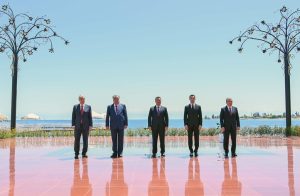The fourth Consultative Meeting of the Central Asian heads of states was held in the resort town of Cholpon-Ata on the shores of Issyk-Kul in Kyrgyzstan on July 21. The current leaders of the five Central Asian countries – Kazakhstan, Kyrgyzstan, Tajikistan, Turkmenistan, and Uzbekistan – all attended the meeting. Kazakhstan’s President Kassym-Jomart Tokayev and Uzbekistan’s President Shavkat Mirziyoyev were welcomed by the host, Kyrgyz President Sadyr Japarov, on July 20, whereas Tajikistan’s Emomali Rahmon and Turkmenistan’s Serdar Berdimuhamedov arrived in Cholpon-Ata on the morning of July 21.
A lot has happened in both individual Central Asian states and in the world since the Central Asian leaders met last year in Turkmenistan. In 2022 alone, there has been domestic political upheaval in Kazakhstan in January 2022, the Russian invasion of Ukraine beginning in February 2022, elections in Turkmenistan, and the recent instability in Uzbekistan in the beginning of July. And yet the fourth Consultative meeting of the heads of the Central Asian states went ahead, demonstrating its consistent character and the extent to which the Central Asian leaders attach a value to its endurance. One cannot help but notice that this new, informal political format in Central Asia, first introduced in 2018, has already survived major instabilities: the power transition in Kazakhstan in spring of 2019, the COVID-19 pandemic beginning in early 2020, political chaos in Kyrgyzstan in October 2020, and the Taliban’s return to power in neighboring Afghanistan in August 2021.
The Consultative Meetings in Central Asia are all about gathering together in order to discuss the pressing issues of the region and coming up with useful recommendations, while avoiding being involved in legally binding commitments. This new formula for renewed regional cooperation in Central Asia seems to be working quite well compared to the previous attempts of the Central Asian states to forge rigorous, formal regional integration institutions with mutually binding legal agreements. The latter approach did not lead to a productive regional cooperation throughout the 1990s and the early 2000s. Instead, the Central Asian countries found themselves void of political trust, less interconnected, and culturally distant by the early 2000s. The sad story of both the Central Asian Union (1994-2001) and the Central Asian Cooperation Organization (2001-2005), which ceased to exist as fully-fledged regional institutions, convincingly illustrate this point.
Fast forward to 2022, and the fourth Consultative Meeting brought considerable results by leading to a joint declaration, as has been the case in previous meetings, and, more importantly, to the signing of the Agreement on Friendship, Good-Neighborliness and Cooperation for Development of Central Asia in the 21st century, which was proposed by Tokayev during the third Consultative Meeting. The agreement has been signed by the heads of Kazakhstan, Uzbekistan, and Kyrgyzstan, while it was concluded that the leaders of Tajikistan and Turkmenistan would sign the document after having undergone certain domestic political procedures.
Another important development was the first meeting of the foreign ministers of the Central Asian states, held a day before this year’s Consultative Meeting itself. This is seen as one of the main steps toward the consolidation of political trust among leaders and officials in the region. The proposal for a foreign minsters’ meeting had been voiced since the first Consultative Meeting held in Nur-Sultan in 2018 and has now come to fruition.
Another document that was signed by the heads of the Central Asian countries is the concept for interaction between Central Asian states in multilateral frameworks, which was proposed by the president of Kazakhstan during the meeting. Tokayev pointed out that “regarding the cooperation with the strategic partners outside the region, Kazakhstan considers that the Concept of interaction between Central Asian states in multilateral frameworks is possible.” He added, “I think that we should not limit ourselves within the fixed geographical frontiers. High-level representatives from the neighboring countries such as Russia and China could attend the Consultative Meetings as the invited guests.”
If realized, this new proposal would change the nature of the Consultative Meetings from being a purely Central Asian platform into something akin to the Commonwealth of Independent States or the Shanghai Cooperation Organization, thus burying another Central Asian regionalism project, as was the case with the CAU and the CACO. On the other hand, the proposal might be considered as a reiteration of goodwill by Central Asian states. A similar sentiment was expressed in the first Joint Declaration of 2018, which highlighted the openness of this platform to any third party to participate. In that sense, Tokayev’s comment once again makes clear that the Consultative Meetings do not entail the creation of any alliance or alignment against a third country during these uneasy geopolitical circumstances, which require careful actions and clear expression of intentions.
By the same token, the Central Asian leaders emphasized the necessity of diversifying trade routes under the current difficult geopolitical context by highlighting the importance of South Asia in offering an alternative route. Furthermore, the leaders pointed to security as a vital dimension that requires mutual cooperation and coordination in the region. Besides these issues, climate change, glacier shrinkage, recovering the Aral Sea, and maintaining water, food, and energy security were mentioned as pressing items on regional agenda.
In the meantime, the joint declaration of the fourth meeting has included a new principle – the inviolability of state borders – along with the principle of territorial integrity, which was included in the second joint declaration issued in 2019. It signifies that the Central Asian states seek to express their collective stance regarding external incursions.
Moreover, the joint declaration defined the Consultative Meetings “as the unique mechanism of maintaining political dialogue, discussing and identifying further perspectives of regional interactions on a high level,” thus making the character of this new format clear and marking its consistent nature. The Consultative Meetings are now a new normal in Central Asia.

































